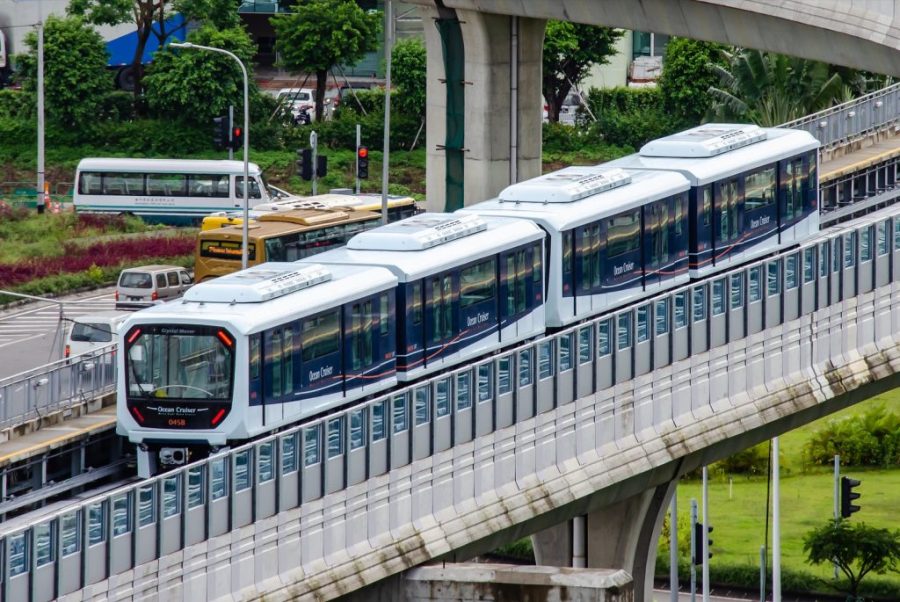The Taipa section of the Light Rail Transit (LRT), which started service last week, had 68,800 passengers in the first three days of its operation, the government-owned operator has announced.
According to a statement on Friday by the operator, officially named “Macao Light Rapid Transit Corporation, Limited” in English, there were 15,600 passengers, 26,400 passengers and 26,800 passengers using Macau’s first-ever railway on Tuesday, Wednesday and Thursday respectively.
It means that the LRT Taipa section had 22,933 passengers per day on average during the three-day period, roughly matching the figure mentioned by Secretary for Transport and Public Works Raimundo do Rosário, who told reporters after the railway’s inauguration ceremony on Tuesday morning that government estimates that the LRT Taipa section will have 20,000 passengers per day during the initial period of its operation. But he was quick to add at that time that the real number of passengers would possibly be rather different from the estimated number due to Macau’s “lack of experience” in operating a railway system.
Passengers can take free LRT rides until December 31. The Taipa section includes Cotai.
The first LRT ride departed from the Taipa Ferry Terminal station – the eastern terminus of the Taipa section – on time at 3:33 p.m. on Tuesday.
During the three-week free-of-charge period which started on the first day of the operation, passengers need to obtain a one-way token from LRT staff to enter the paid area to take a ride.
The 9.3-kilometre-long Taipa section has 11 stations.
The LRT Taipa section operates from 6:30 a.m. to 11:15 p.m. from Mondays to Thursdays, and from 6:30 a.m. to 11:59 p.m. from Fridays to Sundays and on public holidays. Each train departs every five to seven minutes.
Each driverless LRT train consists of two or four carriages, with each carriage carrying up to 90 passengers.
The government announced the LRT fare system last Tuesday – the day when the railway started operating – in a chief executive order published in the Official Gazette (BO).
Under the LRT fare system, which will take effect on New Year’s Day, passengers buying a token with cash will have to pay six patacas per trip comprising up to three stations, eight patacas per trip comprising up to six stations, and 10 patacas per trip comprising up to 10 stations.
The newly announced LRT fare system is different from the city’s public bus fare system which charges a single fare irrespective of the number of bus stops during a passenger’s bus ride.
Currently, all passengers paying with cash have to pay six patacas per trip on all public bus routes.
Under the LRT fare scheme, those using a stored-value LRT card will enjoy a 50 percent discount.
Pupils and students – holding a student version of the LRT card – will enjoy a 75 percent discount. Children under the height of one metre don’t need to pay.
The discounted fare covers local pupils, all students enrolled in local higher education institutions and local residents enrolled in tertiary education institutions elsewhere, according to the chief executive order.
Local senior citizens aged 65 and above and the disabled – holding their respective versions of the LRT card – will be exempt from paying any LRT fares.
Several passengers told The Macau Post Daily during an LRT ride on Saturday that they liked it, even though some said they found it “a bit bumpy”. All said they were looking forward to the LRT’s extension to the peninsula. “Without connecting it to [the peninsula] of Macau it’s just like a fun ride in an amusement park,” a local passenger in his 60s said, while another said that without extending the LRT to the Barrier Gate checkpoint and other areas on the peninsula it would just be “a very expensive toy.”
Rosário told reporters on Tuesday that the Taipa section cost between 10.1 billion and 10.2 billion patacas. He also said that the first LRT station on the peninsula, near Ma Kok Temple, was slated to open in 2023. The station, which is under construction, is known as Barra (“Harbour Entrance”) in Portuguese.






